


Snoqualmie Railroad Days is the annual community festival celebrating Snoqualmie's spirit and origins as a railroad and logging town. The event is held downtown around the Northwest Railway Museum. Volunteer firemen and their wives organized the first festival in 1938, and the popular event is still going strong. Last year about 10,000 visitors attended the festival. This years celebration was held from 14 to 16 Aug 2015. The event includes, a parade, entertainment, kid's face painting, vendors, timber sports demonstrations, classic cars, artisans displays, food and drink venues as well as the Fireman's Pancake Breakfast that started it all. And let's not forget the steam locomotive hauled train rides to North Bend and Snoqualmie Falls.
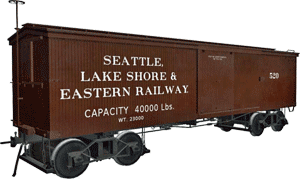 The town of Snoqualmie lies along a railway that was once known as the Seattle Lake Shore & Eastern Railway (SLS&E). This railroad was founded on 28 Apr 1885, just 7 months before the Last Spike was driven into the Canadian Pacific Railway at Craigellachie in British Columbia. The SLS&E was constructed north and east to exploit the resources of the Cascade Range with the hopes of connecting Seattle to a transcontinental rail line, somewhere. By 1887 the line was open for business using 4-4-0 American locomotives such as the D.H. Gilman.
The town of Snoqualmie lies along a railway that was once known as the Seattle Lake Shore & Eastern Railway (SLS&E). This railroad was founded on 28 Apr 1885, just 7 months before the Last Spike was driven into the Canadian Pacific Railway at Craigellachie in British Columbia. The SLS&E was constructed north and east to exploit the resources of the Cascade Range with the hopes of connecting Seattle to a transcontinental rail line, somewhere. By 1887 the line was open for business using 4-4-0 American locomotives such as the D.H. Gilman.
The SLS&E first built its line from Seattle harbour near Columbia Street in old Downtown along Elliot Bay to Ballard. Lines were then extended through Bothell to Woodinville, Snoqualmie, and on to Sallal Prairie, just past North Bend.
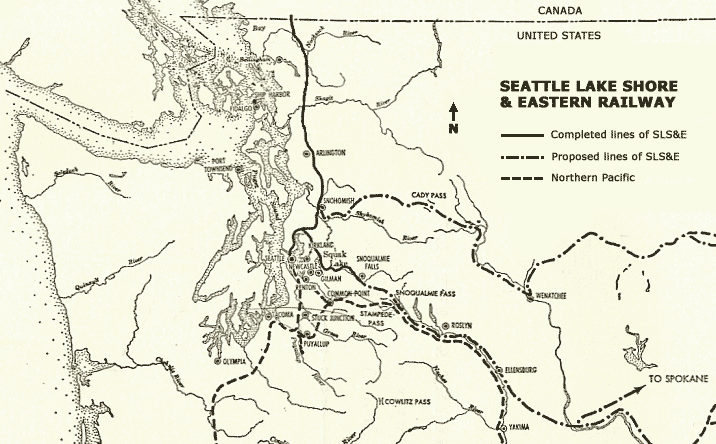
By the late 1880's the SLS&E needed more capital to continue their construction efforts but by the end of 1889 construction had ended having only reached Sallal Prairie. By June of 1889 regular tourist excursions ran from Seattle to a platform overlooking Snoqualmie Falls. Once there, visitors could get off the train, eat a meal at the Snoqualmie Falls Hotel, and climb out onto the rocks to view the falls.
In 1890 their plans were amended to focus on connecting Seattle to the Canadian Pacific Railway at Sumas on the Canadian border.
By late 1892 the SLS&E had completed 126.30 miles of trackage from Seattle to Sumas with branches of approximately 24.5 miles from Seattle through Bothell, and 38.45 miles from Woodinville Junction to Sallal Prairie about 63 miles from the Seattle depot.
 The SLS&E was planned to be a larger railroad than it ultimately became. Construction was in two parts, with the western Washington section noted above. The eastern Washington section, started at Spokane and headed west, was begun in the late 1880s by the Seattle & Eastern Construction Company financed mostly by a group of SLS&E investors. This eastern Washington line became the Spokane & Seattle Railway which was later purchased by the Northern Pacific Railway.
The SLS&E was planned to be a larger railroad than it ultimately became. Construction was in two parts, with the western Washington section noted above. The eastern Washington section, started at Spokane and headed west, was begun in the late 1880s by the Seattle & Eastern Construction Company financed mostly by a group of SLS&E investors. This eastern Washington line became the Spokane & Seattle Railway which was later purchased by the Northern Pacific Railway.
By 1901 the SLS&E was also purchased by the Northern Pacific which was subsequently absorbed by the Burlington Northern Railway in 1970. The western lines remained in fairly heavy use until 1963, but in 1971, Burlington Northern filed to abandon them. Years later they became biking and hiking trails except for a 5.5 mile section of railway between Snoqualmie Falls and North Bend which was preserved in 1975. It is now owned and operated by the Northwest Railway Museum.
Snoqualmie Depot
The Snoqualmie depot was constructed by the SLS&E in 1890. At the time of its building, the depot was unusually elaborate in comparison to the modest size of Snoqualmie at the turn of the century. Through its years of service and multiple ownership changes it underwent so many renovations that it was no longer recognizable as a former train station. When Burlington Northern abandoned the line it donated the depot building and several miles of track to the Northwest Railway Museum. In 1981, the Museum rehabilitated and restored the depot back to its 1890s appearance. Preservationists restored the distinctive turret above the ticket office with its two curved "eyebrow dormer" windows that had been removed in 1948 because of their tendency to leak during heavy rains. At this time, the Depot's heating, electrical system, and public restrooms were brought up to modern standards. A fire suppression system was added both inside and outside the building. In 1996, the cedar shingle roof was replaced with a new version copied from period photographs. In 2010 the public restrooms were updated again to comply with revised building codes and accessibility requirements and to incorporate water-saving devices. The Snoqualmie depot is the oldest continuously operating train depot in the state of Washington. It is listed on the National Register of Historic Places.
Snoqualmie Falls Depot
The SLS&E played a very important role in the location and construction of the hydro electric plant at Snoqualmie Falls. It helped support early tourism and development of the region. During construction of the first plant in 1898-1899 the work relied upon the railroad for almost everything including construction materials, equipment, food, dry goods, mail, and people.
The Snoqualmie Falls depot was built around 1900 and remains in its original location parallel to the railroad. It was ideally located to recieve shipments of equipment and supplies as well as workers and tourists.
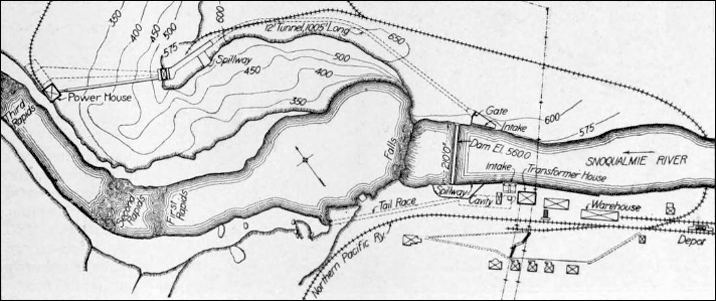
The first hydro electric plant is encased in bedrock 260 feet beneath the surface. It was the world's first completely underground power plant. The second plant, located a quarter-mile downstream from the falls, was built in 1910 and expanded in 1957. A gatehouse, part of the second plant construction, fed water through the penstocks to a powerhouse below on the river. The two plants together currently have 54 megawatts of generating capacity.
During construction of the second power plant a narrow gauge railroad was constructed on an incline from a junction at the Snoqualmie Falls depot down to the Snoqualmie River where a ferry shuttled narrow gauge railroad cars across to the opposite bank with material for the construction of power plant two.
 The train this year was pulled by "Chiggen", formally known as Santa Cruz Portland Cement Number 2. This 0-4-0ST was built in 1909 by the H.K. Porter Company at Pittsburgh, Pennsylvania. H.K. Porter became one of the largest producers of industrial locomotives building almost eight thousand with the last locomotive being built in 1950. "Chiggen" was purchased by Efstathios Pappas in 2006 and restored to its present condition at the Mount Raineer Scenic Railroad shops. Chiggen served as a billboard for a fried chicken restaurant in California for over 30 years before rebuilding.
The train this year was pulled by "Chiggen", formally known as Santa Cruz Portland Cement Number 2. This 0-4-0ST was built in 1909 by the H.K. Porter Company at Pittsburgh, Pennsylvania. H.K. Porter became one of the largest producers of industrial locomotives building almost eight thousand with the last locomotive being built in 1950. "Chiggen" was purchased by Efstathios Pappas in 2006 and restored to its present condition at the Mount Raineer Scenic Railroad shops. Chiggen served as a billboard for a fried chicken restaurant in California for over 30 years before rebuilding.
Specifications Santa Cruz Portland Cement Number 2
Built: August 1909
Manufacturer: H.K. Porter Co.
Builders number: 4390
Type: 0-4-0ST
Drivers: 46 inches
Cylinders: 15 x 24 inches
Boiler pressure: 175 Pounds per square inch
Weight in running order: 87,000 Pounds
Tractive effort: 18,500 pounds
Adhesion factor: 4.9
With "Chiggen" on the head-end the train consisted of five cars, two coaches, combine (third car from the head-end), a coach with individual fabric upholstered seats, and an observation car. The second coach, number 218 in particular, was nicely refurbished with wood siding and plush seats lettered for the Spokane Portland & Seattle Railway. It was built by Barney & Smith in 1912. The combine is run with the doors open and a safety fence which offers a clear camera view of the passing sights. Bringing up the tail-end an open rear platform observation car carries a staff member for safety and security. He operated a Marslight and air chimes mounted on the rear railing. This is required because the train is not turned at either end of a trip nor does the locomotive run-around the train.
Train trips operated from 11:30 to 16:45 for each of the three days of the event. They departed from the Snoqualmie depot with the train backing to North Bend. From North Bend "Chiggen" headed the train back to Snoqualmie depot but the train did not stop there. It carried straight past the station to Snoqualmie Falls, past the Snoqualmie Falls depot (The depot and adjacent carpenter shop are now a museum featuring excellent exhibits about the Snoqualmie Falls hydro electric plants.), and stopped at the end of the line. There is a view of Snoqualmie Falls from the head-end coaches but the view from the rear cars is blocked by the forest. After a brief wait the train returned to Snoqualmie, with a pause, while the baggage car was lined up with the grade crossing so a wheelchair access lift could board two persons in wheelchairs. The train then backed up to the station platform to unload passengers. Total duration of the trip was about an hour and ten minutes.
19 May 1888 - Announcement of Contract to Build the Seattle Lake Shore & Eastern
24 Nov 1888 - First Train on the Seattle Lake Shore & Eastern
2 Mar 1890 - A Big Conspiracy
13 Aug 2015 - Railroad Days Celebrates Snoqualmie's Unique History
13 Aug 2015 - Depot to Mark 125th Anniversary
13 Aug 2015 - Steam Train Restoration Underway at Museum
15 Aug 2015 - Snoqualmie Railroad Days
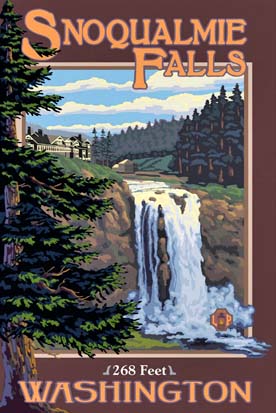
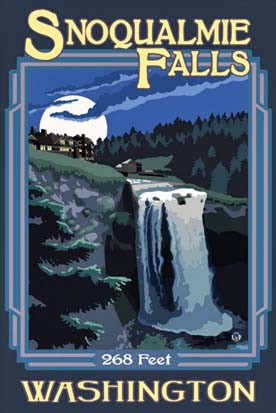
Northwest Railway Museum
White River Lumber Company Caboose Restoration
The Museum (scroll sideways)
Northern Pacific Railway Historical Association
Burke-Gilman Trail History
Snoqualmie Falls Hydroelectric Museum
Redmond Railway Depot
Issaquah Depot Museum
Michael James Heney
The Economic Development of Seattle During the Rail Age, 1870-1920




